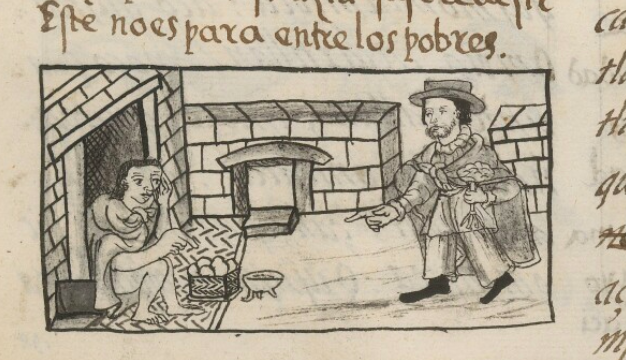necuacehualhuiloni (FCbk6f194v)
This iconographic example, featuring a hat (necuacehualhuiloni) is included in this digital collection for the purpose of making potential comparisons with related hieroglyphs. The term selected for this example comes from the keywords chosen by the team behind the Digital Florentine Codex. There is no gloss. This example shows the head of a man in a ¾ view, looking toward the left. As the contextualizing image shows, he has adopted European-style dress, including a bowler hat, a ruffled collar, a tunic, trousers, and black shoes. But he still wears a Nahua-style cape (tilmatli) and he is carrying what seems to be a Nahua-type of flower bouquet (perhaps a maxochitl). The hat has a round brim and a round crown. The crown is somewhat flat. This hat is a European introduction to Nahua culture. The significant beard this man wears may suggest he is a biological mestizo.
Stephanie Wood
In this digital collection, bowler hats are often found on the heads of Europeans. But members of the Indigenous town council (cabildo) could be inclined to adopt European-style hats. Also, glyphs for the name Mocauhqui seem to show Indigenous men wearing bowlers. Earlier Nahua hats were more likely to come to a point at the top. See below.
Stephanie Wood
1577
Jeff Haskett-Wood
sombreros, el sombrero hongo
necuacehuahuiloni, a hat, https://nahuatl.wired-humanities.org/content/necuacehualhuiloni
el sombrero
Stephanie Wood
Available at Digital Florentine Codex/Códice Florentino Digital, edited by Kim N. Richter and Alicia Maria Houtrouw, "Book 6: Rhetoric and Moral Philosophy", fol. 194v, Getty Research Institute, 2023. https://florentinecodex.getty.edu/en/book/6/folio/194v/images/0 Accessed 9 July 2025.
Images of the digitized Florentine Codex are made available under the following Creative Commons license: CC BY-NC-ND (Attribution-NonCommercial-NoDerivs 4.0 International). For print-publication quality photos, please contact the Biblioteca Medicea Laurenziana ([email protected]). The Library of Congress has also published this manuscript, using the images of the World Digital Library copy. “The Library of Congress is unaware of any copyright or other restrictions in the World Digital Library Collection. Absent any such restrictions, these materials are free to use and reuse.”






